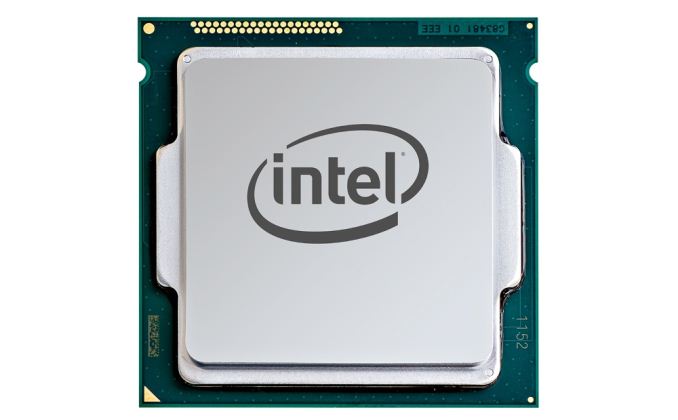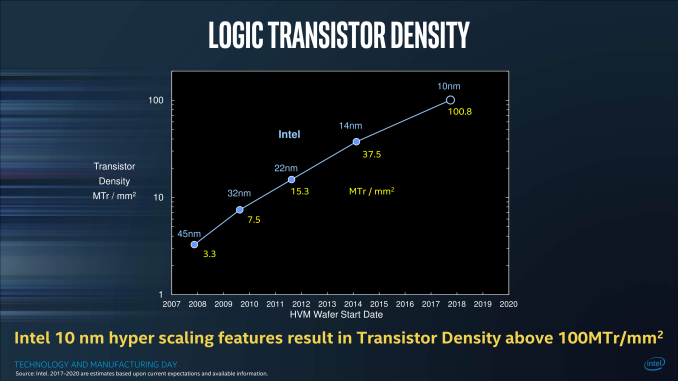Intel Officially Reveals Post-8th Generation Core Architecture Code Name: Ice Lake, Built on 10nm+
by Ian Cutress on August 15, 2017 9:20 AM EST- Posted in
- CPUs
- Intel
- Core
- Coffee Lake
- Ice Lake
- Cannon Lake

In an unusual move for Intel, the chip giant has ever so slightly taken the wraps off of one of their future generation Core architectures. Basic information on the Ice Lake architecture has been published over on Intel's codename decoder, officially confirming for the first time the existence of the architecture and that it will be made on Intel's 10nm+ process.
This is an unexpected development as the company has yet to formally detail (let alone launch) the first 10nm Core architecture – Cannon Lake – and it's rare these days for Intel to talk more than a generation ahead in CPU architectures. Equally as interesting is the fact that Intel is calling Ice Lake the successor to their upcoming 8th generation Coffee Lake processors, which codename bingo aside, throws some confusion on where the 14nm Coffee Lake and 10nm Cannon Lake will eventually stand.
As a refresher, the last few generations of Core have been Sandy Bridge, Ivy Bridge, Broadwell, Haswell, Skylake, with Kaby Lake being the latest and was recently released at the top of the year. Kaby Lake is Intel’s third Core product produced using a 14nm lithography process, specifically the second-generation ’14 PLUS’ (or 14+) version of Intel's 14nm process.
Meanwhile when it comes to future products, back at CES Intel briefly showed a device based on post-Kaby Lake designs, called Cannon Lake and based on their 10nm process. Since then Intel has also confirmed that the 8th Generation of processors for desktops, called Coffee Lake, will be announced on August 21st (and we recently received promotional material to that effect). Ice Lake then, seems poised to follow both Coffee Lake and Cannon Lake, succeeding both architectures with a single architecture based on 10nm+.
Working purely on lithographic nomenclature, Intel has three processes on 14nm: 14, 14+, and 14++. As shown to everyone at Intel’s Technology Manufacturing Day a couple of months ago, these will be followed by a trio of 10nm processes: 10nm, 10nm+ (10+), and 10++,
On the desktop, Core processors will go from 14 to 14+ to 14++, such that we move from Skylake to Kaby Lake to Coffee Lake. On the Laptop side, this goes from 14 to 14+ to 14++/10, such that we move from Skylake to Kaby Lake to Coffee Lake like the desktops, but also that at some time during the Coffee Lake generation, Cannon Lake will also be launched for laptops. The next node for both after this is 10+, which will be helmed by the Ice Lake architecture.
| Intel's Core Architecture Cadence | |||||
| Microarchitecture | Core Generation | Process Node | Release Year | ||
| Sandy Bridge | 2nd | 32nm | 2011 | ||
| Ivy Bridge | 3rd | 22nm | 2012 | ||
| Haswell | 4th | 22nm | 2013 | ||
| Broadwell | 5th | 14nm | 2014 | ||
| Skylake | 6th | 14nm | 2015 | ||
| Kaby Lake | 7th | 14nm+ | 2016 | ||
| Coffee Lake | 8th | 14nm++ | 2017 | ||
| Cannon Lake | 8th? | 10nm | 2018? | ||
| Ice Lake | 9th? | 10nm+ | 2018? | ||
The way that the desktop and laptop markets will be diverging then converging is confusing a lot of people. Why is the laptop market splitting between 14++ and 10, and why is the desktop market not going to 10nm but straight to 10+? What lies beyond is a miasma of guess work, leaked slides, and guessing Intel’s strategy, but I believe the answer lies in Intel’s manufacturing technologies and the ability to move to newer lithographic nodes.
(We should interject here that the naming of a lithographic node has slowly lost its relevance between the features of the process and the actual transistor density and performance, such that TSMC’s improved 16FF+ is called 12FFN, but relies on similar transistor sizes with enhanced attributes. But 12 is a smaller number than 14, which is the marketing angle kicking in. By all accounts, Intel has typically been considered the more accurate foundry when it comes to numerical lithographic naming of the process, which others consider is to their detriment.)
Intel originally predicted that they would move to 10nm almost a year ago, at the end of 2016 and 2 years after the launch of their 14nm process. But the challenge in managing the technology required to advance to their version of 10nm has been fraught with difficulty. In all cases it can depend on external equipment, fine tuning a process, or getting acceptable yields – while one manufacturer might be satisfied with an 80% yield, another might consider that a failure. Being able to obtain high yields (ramp up) will also be a function of die size, and so the newest nodes are typically launched with smaller mobile parts in mind first, as the yields for smaller parts are better than larger parts at the same defect rate.
Simply put, the first generation of 10nm requires small processors to ensure high yields. Intel seems to be putting the smaller die sizes (i.e. anything under 15W for a laptop) into the 10nm Cannon Lake bucket, while the larger 35W+ chips will be on 14++ Coffee Lake, a tried and tested sub-node for larger CPUs. While the desktop sits on 14++ for a bit longer, it gives time for Intel to further develop their 10nm fabrication abilities, leading to their 10+ process for larger chips by working their other large chip segments (FPGA, MIC) first.
From a manufacturing standpoint, Intel has been using multiple patterning techniques in its 14nm processes, and the industry is looking to when the transition to EUV will take place. Anton has some great writeups of the state of EUV and how different companies are transitioning to smaller nodes - they are well worth a read.
- EUV Lithography Makes Good Progress, Still Not Ready for Prime Time
- Samsung and TSMC Roadmaps: 8 and 6 nm Added, Looking at 22ULP and 12FFC
- GlobalFoundries Updates Roadmap: 7 nm in 2H 2018, EUV Sooner Than Later?
The crux of the matter is that EUV would shorten time to market and arguably make the process easier (if only more expensive), and several fab companies are waiting for Intel to jump onto it first. With EUV not ready, Intel has had to invest into deeper multi-patterning techniques, which raise costs, decrease yields, and increase wafer process times considerably.
All of which leads to a miasma of increased delays, much to the potential chagrin of investors but also customers who had banked on the power improvements that a typical new lithography node brings. Intel is still keeping spirits high, by producing numbers that would suggest that their methodology is still in tune with Moore’s Law, even if the products seem to be further strung out. Some analysts concur with Intel’s statements, while others see it as hand-waving until 10/10+ hits the market. Intel would also point out that it is developing other technologies such as Embedded Multi-Die Interconnect Bridges (EMIB) to assist in equipping chip with high-speed fabric or glue-logic.
Given its position as a post-8th gen architecture, Ice Lake is likely to hit sometime in 2018, perhaps 2019, depending on Intel’s rate of progress with larger chips and the 10+ process. Intel’s other market segments, such as FPGAs (Altera), Xeon Phi (MIC) and custom foundry partners, are also in the mix to get into some 10nm action.
(Note that Intel’s next generation of Xeon Scalable Processors is called Cascade Lake, a 2018 refresh of the Skylake generation launched this year.)
Source: Intel


















106 Comments
View All Comments
Stochastic - Tuesday, August 15, 2017 - link
The only reason to wait is that RAM prices might decline later in 2018. Although I read a recent support saying that the NAND shortage will extend into 2019 potentially. Right now is a particularly bad time to build a new PC because of the double whammy of inflated RAM and SSD prices + inflated GPU prices due to the mining craze. Hopefully things will settle down sooner rather than later.Stochastic - Tuesday, August 15, 2017 - link
*recent reportAlexvrb - Tuesday, August 15, 2017 - link
I hope so. SSD pricing has been flat (which is still absurd given density increases), but RAM costs have actually gone up quite a bit and GPUs obviously are through the roof. Just waiting for Eth to go Proof of Stake. Sigh.zodiacfml - Tuesday, August 15, 2017 - link
A new process node is worth it for mobile...and server parts.Netmsm - Tuesday, August 15, 2017 - link
It's just an attempt to halt in selling Ryzen.TEAMSWITCHER - Tuesday, August 15, 2017 - link
I won't ever build an AMD machine again. That ship has sailed.Netmsm - Tuesday, August 15, 2017 - link
And that's only your way and your problem too not realistic ones!coder543 - Tuesday, August 15, 2017 - link
That seems like a sound, thought-out argument built upon troves of market analyses.Thanks for sharing with the rest of us.
artk2219 - Tuesday, August 15, 2017 - link
You're not quite living up to your username man :-/ .Netmsm - Tuesday, August 15, 2017 - link
What a prophecy!it's obvious that analogizing Intel and AMD in terms of their cap is not a true debate (which has been brought up in other comments)! in the other hand, siding with Intel, as the giant of the semiconductor industry, by mentioning its potential capacities/abilities seems like blindly following the stronger!
however, the hurry-scurry announcements of Intel - at least - show what Intel could've produced but didn't. and what it means?